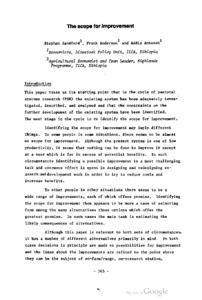The performance of index based livestock insurance: ex ante assessment in the presence of a poverty trap
This paper evaluates the effectiveness of a new index-based livestock insurance (IBLI)
product designed to compensate for area average predicted livestock mortality loss in
northern Kenya, where previous work has established the presence of poverty traps. We
simulate household-specific wealth dynamics based on a model parameterized using rich
panel and experimental data from the region. The simulations allow us to investigate
patterns of willingness to pay for asset index insurance that is imperfectly correlated with
The implications of spontaneous range enclosure for African livestock development policy
This paper examines a process - the spontaneous enclosure of the range by livestock owners - which may rise new problems but also permit new approaches to the development of the African livestock industry. Drawing on case material from Sudan and Somalia, the opening section of the paper discusses some of the spontaneous range enclosure.
The role of risk management in pastoral policy evaluation and poverty reduction
The political economy of livestock and pastoralism in Sudan
The importance of wealth effects on pastoral production: A rapid method of wealth ranking
Discusses the importance of wealth differences among producers in traditional pastoral production systems, describing a rapid method, dependent on informants, for determining the wealth rank of producers within a given community in order to stratify a population of producers before sampling.
The scope for improvement
Discusses the need for identifying sociological and economic possibilities for improvement in pastoral production systems, mentioning the major steps involved, particularly, identification of potential improvements, prediction of their likely impact on net production & quality of life; prediction of the probability of adoption; and assessment of the rapidity with which the improvements will bear fruit.
The potential benefits and challenges of agricultural animal biotechnology to pastoralists
The livelihoods of pastoralists revolve around their indigenous livestock. Combining high
production with disease resistance using genetic engineering is a biotechnological intervention
hailed by some as a promising avenue to mitigate food insecurity and poverty. Considerable
human and financial resources have already been devoted to exploring this option. However, the
challenges are enormous. It is unlikely that such livestock would survive in the harsh ecosystems
The sedentarisation process of the Bahima in Uganda: an emic view
The traditional lifestyle of nomadic pastoralists is vanishing rapidly, because of human population growth which often leads to land scarcity or political pressure on pastoralists to settle. The sedentarisation of the Bahima pastoralists in Western Uganda started in the 1940s and is still going on. In this study former nomadic cattle keepers, who have settled with their families, were interviewed in order to document the decision to settle and the subsequent changes in the lifestyle of these people. All interviewees expressed their satisfaction with their sedentary life.
The productivity and potential of pastoral systems
Examines the productivity of East African pastoral systems in terms of animal protein & energy production, milk offtake and livestock production parameters such as calving percentage, calf mortality and herd structure; compares the productivity of East African pastoral systems to those of commercial ranches and to pastoral systems in other parts of the world.
The Kenyan rangeland ecological monitoring unit (KREMU)
Discusses the Kenya Rangeland Ecological Monitoring Unit (KREMU), mentioning its objectives, initial tasks related to identifying ecological units, testing survey methods, training of staff & designing appropriate computer programmes; describes the Unit's achievements, with emphasis on ecological surveys & censuses carried out within the framework of on-going ecological monitoring programmes; outlines problems encountered.











